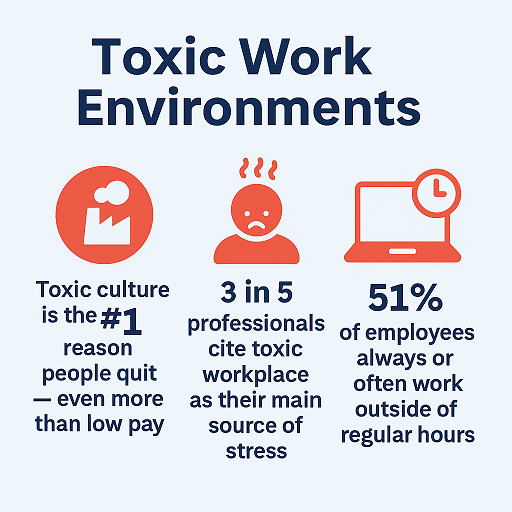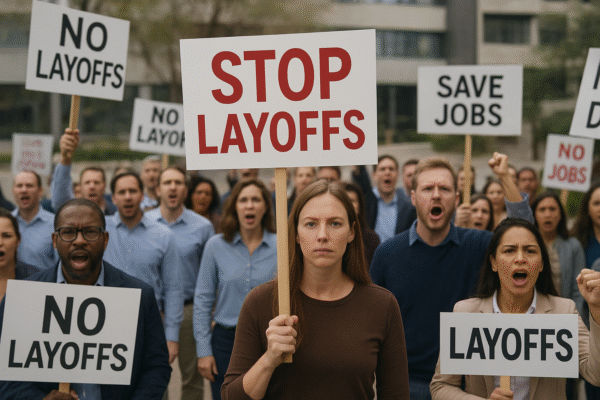It was a Tuesday morning. The office clock ticked sluggishly, but my heart raced. Not because I was busy — I was always busy anyway — but because I had just received another all-caps email about “URGENT” work that somehow had to be done yesterday. The worse was yet to come — after 10 minutes — our “status update” meeting.
I wasn’t just in a stressful job. It was toxic job in a toxic work environment — and it was taking more from me than I realized.
The constant criticism, unrealistic expectations, and passive-aggressive comments had become normal. Or at least, I thought they had. I told myself “It’s just work, everyone deals with this.”
But deep down, I knew better.
☠️ What Exactly Is a Toxic Job?
A toxic job isn’t simply one you dislike. It’s an environment that consistently damages your mental, emotional, and sometimes physical well-being. According to a MIT Sloan Management Review study of over 34 million online employee profiles, a toxic culture is the #1 reason people quit — even more than low pay.
Common traits include:
- 🗯 Persistent negativity — gossip, backstabbing, or constant conflict
- 📋 Micromanagement — no trust, only control
- ⏳ Unrealistic workloads — chronic overwork without support
- 🚫 Lack of growth — no learning or promotion opportunities
- 🛑 Disrespect — verbal abuse, discrimination, or harassment
When these become routine, they don’t just make you dread Mondays — they can harm your health.
🔒 Why People Stay (Even When They Want to Leave)
If you’ve been telling yourself “I’ll leave when it gets unbearable,” here’s the truth — it’s probably already unbearable, but there are psychological traps keeping you stuck:
- 💸 The Sunk Cost Fallacy
“I’ve already put five years here, I can’t waste that.”
→ Reality: The more you stay, the more you lose. - 😨 Fear of the Unknown
“What if the next job is just as bad?”
→ Reality: Without research and clarity, you risk jumping into the same trap. - 🧾 Financial Dependency
Bills, loans, family obligations — they make quitting feel impossible. - 🌀 Normalization of Dysfunction
If toxic behaviors happen every day, they can start to feel normal.
🚩 How to Know It’s Time to Get Out
While every job has tough days, here are red flags that you’re dealing with sustained toxicity:
- 🤢 You feel physically ill thinking about work
- 💔 Your confidence is eroding — you doubt your abilities constantly
- 😑 You’ve stopped caring about quality because nothing seems to matter
- 🚷 There’s zero trust between leadership and staff
- ❌ You can’t remember the last time you felt valued
If two or more of these ring true, it’s time to plan your exit.

🛠 Getting Out — Without Burning Bridges or Burning Out
Escaping a toxic job isn’t as simple as handing in your resignation. It’s about strategic exit planning to protect your mental health, finances, and career reputation.
1️⃣ Strengthen Your Safety Net First
Start wise. Before you make any moves:
- 💰 Save at least 3–6 months of living expenses (source: National Endowment for Financial Education).
- 🧾 Pay off high-interest debt if possible.
- 🩺 Research your health insurance options post-exit.
2️⃣ Document Everything
If your toxic job environment includes harassment, discrimination, misconduct or unethical practices:
- 🗂 Keep dated emails, messages, and meeting notes.
- 📱 Use a personal device for sensitive records.
- 🛡 This protects you legally and strengthens your case if you need HR or legal support.
3️⃣ Rebuild Your Network (Before You Need It)
Don’t wait to reach out until you’ve quit toxic job:
- 🔗 Reconnect with old colleagues on LinkedIn.
- 🤝 Join professional groups or industry events.
- 🎯 Offer help or share insights — relationships thrive on reciprocity.
A LinkedIn survey found that 70% of jobs are filled via networking.
4️⃣ Upgrade Your Skills in the Background
Use your current role (and paycheck) to prepare for the next:
- 💻 Take online courses in high-demand areas.
- 📂 Volunteer for projects that add to your portfolio.
- 📡 Stay active on industry forums to learn trends.
- Consider pursuing best certifications for mid-career professionals to strengthen your CV before moving on.
5️⃣ Apply Strategically — Not Desperately
When you’re desperate to escape, it’s easy to jump at the first offer. But remember:
- 🗨 Interview the company as much as they interview you.
- 🕵️♀️ Ask about work culture, turnover rates, and leadership style.
- 🔍 Check Glassdoor but also talk to current/former employees.
6️⃣ Protect Your Mental Health in the Meantime
While you’re still in the toxic environment:
- ⛔ Set boundaries — stop answering emails after hours.
- 🌿 Create a recovery practice — a walk, gym session, or mindfulness practice after work.
- 🚪 Limit exposure to toxic colleagues if possible.
- Learn coping strategies to stay resilient until you transition.
7️⃣ Exit Gracefully — Even if You Want to Scream
Resist the urge to burn bridges:
- 📅 Give proper notice.
- 📝 Keep your resignation letter professional.
- 💬 Avoid venting in exit interviews (unless constructive and safe).
Your professional reputation will outlast your current job.
🧘♀️ After You Leave: Detoxing from the Damage
Leaving a toxic job isn’t the end — it’s the beginning of recovery.
- 🛋 Allow Decompression Time
Take a few weeks to rest before jumping into the next role. - 💪 Rebuild Confidence
Seek projects or hobbies that remind you of your strengths. - 📖 Reflect on Lessons Learned
What red flags did you miss before? How will you spot them next time? - ✅ Redefine Your Non-Negotiables
Decide what you will and will not tolerate in your next role.
For strategies on reclaiming your energy and focus, see our Job Burnout – How To Get Over It Within 30 Days article.
✨ You’re Not Stuck — You’re Preparing
When you’re in a toxic job, it’s easy to feel powerless. But every step you take — saving money, building skills, growing your network — is a step toward freedom.
The same MIT Sloan research found that employees who leave toxic cultures often land in roles where they’re more engaged, healthier, and better paid.
So the goal isn’t just to get out.
It’s to get out better.
One day, you’ll look back on this chapter not as the time you were trapped — but as the moment you started building your escape route.
📚 Sources:





Leave a Reply